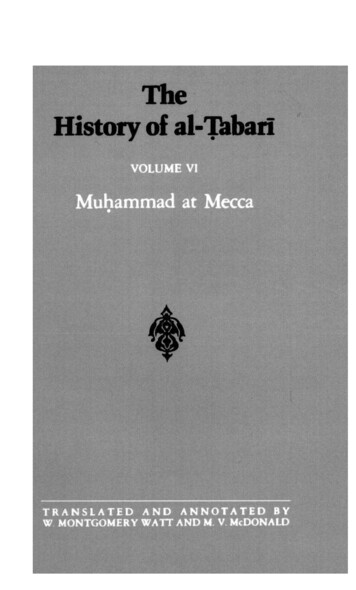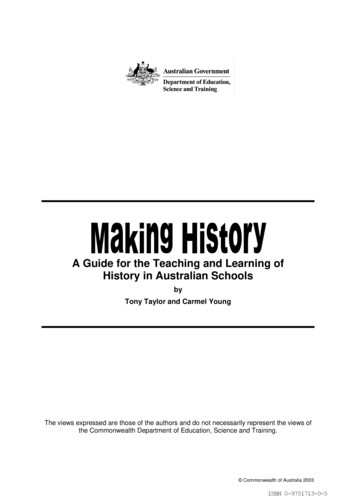
Transcription
TheHistory of al-TabariMuhammad at Mecca
Muhammad at MeccaVolume VITranslated and Annotated byW. Montgomery Wattand M. V. McDonaldThe sixth volume of the translation of al-Taban s Hirtorydeals with the ancestors of Muhammad, with his ownearly life, and then with his prophetic mission up to thetime of his Hijrah or emigration to Medina. The topicscovered mean that this volume is of great importanceboth for the career of Muhammad himself and for theearly history of Islam . Al-Tabari was familiar with, andmade use of, the main early source of these matters, theSinb or life of Muhammad by Iba Ishiiq, a work which isstill extant . Although his own treatment is briefer thanthat of lbn Isbiq , it complements the letter inimportant ways by making use of other sources. Wherelbn lshiq gave only the version of an event which hepreferred. al-Tabari includes any variants which heconsidered of value. Thus he mentions the dispute aboutthe first male to become a Muslim - 'Ali or Abu Bakr orZayd- and has also several variant accounts of the call tobe a prophet. He has much material , too, about thehostility toward Muhammad from many of the leadingMeccans and their attempts to put pressure on his familyto stop his preaching. The negotiations with the men ofMedina which eventually led to the Hijrah are fullydescribed , and there is then an account of howMuhammad escaped an assassination attempt andarrived safely in Medina . A concluding section discussessome chronological questions. This volume does notmerely give a straightforward account of the earliercareer of Muhammad and the beginnings of Islam, butalso contains valuable source -material not easilyaccessible otherwise. or not accessible at all.SUNY Series in Near Eastern StudiesSaid AmirArjomand, EditorP R E S SState University ofNew York Presswww.sunypress.eduISBN 0-88706-707-7900009 780887
THE HISTORY OF AL -TABARIAN ANNOTATED TRANSLATIONVOLUME VIMuhammad at Mecca
The History of al-TabariEditorial BoardIhsan Abbas, University of Jordan, AmmanC. E. Bosworth, The University of ManchesterJacob Lassner, Wayne State University, DetroitFranz Rosenthal, Yale UniversityEhsan Yar-Shater, Columbia University (General Editor)SUNYSERIES IN NEAR EASTERN STUDIESSaid Amir Arjomand, Editor0The general editor acknowledges with gratitude the supportreceived for the execution of this project from the Division ofResearch Programs, 'Translations Division of the National Endowment for the Humanities, an independent federal agency.
Bibliotheca PersicaEdited by Ehsan Yar-ShaterThe History of al-Tabari(Ta'rikh al-rusul wa 'l-muluk)VOLUME VIMuhammad at Meccatranslated and annotatedbyW. Montgomery WattUniversity of Edinburgh, EmeritusandM. V. McDonaldUniversity of EdinburghState University of New York Press
The preparation of this volume was made possible by a grant fromthe Division of Research Programs of the National Endowment forthe Humanities, an independent federal agency.Published byState University of New York Press, Albany 1988 State University of New YorkAll rights reservedPrinted in the United States of AmericaNo part of this book may be used or reproducedin any manner whatsoever without written permissionexcept in the case of brief quotations embodied incritical articles and reviews.For information, address State University of New YorkPress, State University Plaza, Albany, N. Y. 12246Library of Congress Cataloging in Publication DataTabari, 838?- 923.Muhammad at Mecca(The history of al-TabaribTa'rikh al-rusul wa'lmuluk; v. 6) (SUNY series in Near Eastern studies)(Bibliotheca Persica)Translation of extracts from: Ta'rikh al-rusulwa-al-muluk.Bibliography: p.Includes index.1. Muhammad, Prophet, d. 632. 2. Muslims-Saudi Arabia-Biography. I. Watt, W. Montgomery (William Montgomery)II. McDonald, M. V. (Michael V.) 111. Title. IV. Series:Tabari, 838?- 923. Ta'rikh al-rusul wa-al-muluk.English ; v. 6. V. Series: SUNY series in Near Easternstudies. VI. Series: Bibliotheca Persica (Albany, N.Y.)DS 38. 2.T 313 1985 vol. 6 (BP 77. 41909'- 1 s 87- 17949ISBN o- 88706- 706- 9ISBN o- 88706- 707- 7 (pbk.)10 9 8 7 6 5 4 3 2 1
PrefaceTHE HISTORY OF PROPHETS AND KINGS ( Ta'rikh al-rusul wa'1-muluk ) by Abu Ja'far Muhammad b. Jarir al-Tabari 1839-923), hererendered as the History of al-Tabari, is by common consent themost important universal history produced in the world of Islam.It has been translated here in its entirety for the first time for thebenefit of the non-Arabists, with historical and philogical notesfor those interested in the particulars of the text.Tabari's monumental work explores the history of the ancientnations, with special emphasis on biblical peoples and prophets,the legendary and factual history of ancient Iran, and, in great detail, the rise of Islam, the life of the Prophet Muhammad, and thehistory of the Islamic world down to the year 915. The first volume of translation will contain a biography of al-Tabari and a discussion of the method, scope, and value of his work. It will alsoprovide information on some of the technical considerations thathave guided the work of the translators.The History has been divided into 38 volumes , each of whichcovers about two hundred pages of the original Arabic text in theLeiden edition. An attempt has been made to draw the dividinglines between the individual volumes in such a way that each isto some degree independent and can be read as such . The pagenumbers of the original in the Leiden edition appear on the margins of the translated volumes.Al-Tabari very often quotes his sources verbatim and traces thechain of transmission (isnad) to an original source. The chains of
vi Prefacetransmitters are, for the sake of brevity, rendered by only a dash(-) between the individual links in the chain. Thus, accordingto Ibn Humayd-Salamah-Ibn Ishaq means that al-Tabari receivedthe report from Ibn Humayd who said that he was told by IbnIshaq, and so on. The numerous subtle and important differencesin the original Arabic wording have been disregarded.The table of contents at the beginning of each volume gives abrief survey of the topics dealt with in that particular volume.It also includes the headings and subheadings as they appear inal-Tabari's text, as well as those occasionally introduced by thetranslator.Well-known place-names, such as, for instance, Mecca, Baghdad, Jerusalem, Damascus, and the Yemen, are given in their English spellings. Less-common place-names, which are the vast majority, are transliterated. Biblical figures appear in the acceptedEnglish spelling. Iranian names are usually translated accordingto their Arabic forms, and the presumed Iranian forms are oftendiscussed in the footnotes.Technical terms have been translated wherever possible, butsome, such as dirham and imam, have been retained in Arabicforms. Others which cannot be translated with sufficient precision have been retained and italicized as well as footnoted.The annotation aims chiefly at clarifying difficult passages,identifying individuals and place-names, and discussing textualdifficulties. Much leeway has been left to the translators toinclude in the footnotes whatever they consider necessary andhelpful.The bibliographies list all the sources mentioned in the annotation.The index in each volume contains all the names of persons andplaces referred to in the text, as well as those mentioned in thenotes as far as they refer to the medieval period. It does not includethe names of modern scholars. A general index, it is hoped, willappear after all the volumes have been published.For further details concerning the series and acknowledgments,see Preface to Volume i.Ehsan Yar-Shater
16ContentsPreface / vTranslator's Foreword / xiThe Lineage of the Messenger of God / I'Abdallah (His Father) / i'Abd al-Muttalib (His Grandfather) / 9Hashim / i6'Abd Manaf / 18Qusayy / x gKilab / 26Murrah / 26Kab / 27Lu'ayy / 27Ghalib / 28Fihr / 28Malik / 29Al-Nadr / 31Kinanah / 32Khuzaymah / 32Mudrikah / 32Ilyas / 33Mudar / 34Nizar / 36
viii ContentsMa'add / 36'Adnan / 37'Adnan's Descent from Ishmael, Abraham, and Adam / 38The Account of the Messenger of Godand His Life / 44The Messenger of God Is Recognized by theMonk Bahira / 44The Messenger of God Is Protected by God fromParticipating in Pagan Practices / 46The Prophet's Marriage to Khadijah / 47Events of the Life of the Messenger of God / 51The Rebuilding of the Ka'bah / 51History of the Ka'bah / 51The Rebuilding of the Ka'bah [Continued) / 56The Beginning of the Prophetic Mission / 60The Day and the Month on Which the Messenger of GodBecame a Prophet, and the Accounts Concerning This / 62First Revelation of the Qur'an / 62Signs of the Approach of Prophethood / 63Predictions of the Appearance of the Prophet / 64Proofs of Prophethood / 66The Manner in Which the Qur'an Was First Revealed / 67Khadijah the First to Believe in the Messenger of God / 76The First Rituals of Islam Are Prescribed / 77The Prophet Ascends to the Seventh Heaven / 78The First Male to Believe in the Messenger of God / 8oEvents of the Life of the Messenger ofGod (Continued) / 88The Messenger of God Begins to Preach Openly / 88Other Events up to the Hijrah / 93Quraysh Begin to Oppose the Messenger of God / 93
Contents ixThe Emigration to Abyssinia / 98Quraysh Show Increased Hostility to theMessenger of God / totHamzah Accepts Islam / 103'Abdallah b. Mas'dd Recites the Qur'anAloud to Quraysh / 104Quraysh Boycott the Band Hashim andthe Band al-Muttalib / io5Quraysh Attempt to Induce the Messenger of Godto Cease His Attacks on Their Gods / io6Satan Casts a False Revelation on the Messengerof God's Tongue / 107The Boycott Is Repealed / 112The Messenger of God Is Subjected to Further Insults / 114The Deaths of Abd Talib and Khadijah / 115The Messenger of God Goes to al-Ta 'if / 115The Messenger of God Returns to Mecca / 117The Messenger of God Preaches to the Arab Tribes / 120The First Madinans Said to Have Accepted Islam / 122The First Deputation from al-Madinah / 124The First Pledge of al-'Aqabah / 126Islam Begins to Spread in al-Madinah / 127The Second Pledge of al-'Agabah / 130The Messenger of God Commands theMuslims to Emigrate to al-Madinah / 139The Quraysh Plot to Kill the Messenger of God / 140The Messenger of God Escapes from the Attemptto Kill Him / 142The Messenger of God Emigrates to al-Madinah / 145The Messenger of God Arrives in al-Madinah / 150The Beginning of the PropheticMission (Continued) /153The Institution of the Islamic Calendar / 157The Date of the Institution of the Islamic Era / 157Reports on This Subject / 157
x ContentsSummary of Meccan Chronology / 162Abbreviations / 163Bibliography of Cited Works / 165Index / 167
16Translator's Foreword0The Sources and Their ReliabilityThe sourcesIn the latest and most complete history of Arabic literature byFuat Sezgin, nearly fifty pages are devoted to works on the historyof pre-Islamic Arabia and the life of the Prophet, solely for theperiod up to about the year I000 A.D.'There are notices of over seventy writers, even if many of theseare now known only through quotations from them by later authors. This gives some idea, however, of the large amount of written material available to Tabari. For the present volume, he hadthree main sources.The earliest and most important of those sources is Ibn Ishaq,whose book on the Prophet is usually known as the Sirah. Thishas been preserved primarily in the recension of a later scholar, IbnHisham (d.2i 8/833 2 It is known, however, that there were at leastfifteen recensions of Ibn Ishaq's work by various pupils of his, andthere is a little information about how these differed from that ofIbn Hisham 3 Ibn Hisham derived his version mainly from Ziyad b.'Abdallah al-Bakka'i (d.i83/299). Tabari, on the other hand, knewIbn Ishaq through the recension of Salamah b. al-Fadl al-Abrasht. Geschichte des arabischen Schrifttums (GAS), vol. I, Leiden 1967, pp.257-302.2. Ed. Ferdinand Wustenfeld, Gottingen 1858, 1859. For other editions and furtherdetails about Ibn Hisham, see Sezgin, 1:297-99.3. J. Fuck, Muhammed b. Ishaq, Frankfort 1925.
xii Translator's Foreword(d.191/2o6), which was transmitted to him by Ibn Humayd, buthe also sometimes consulted the recension of Yunus b. Bukayr(d.199/214). The Sirah of Ibn Ishaq is accessible to English readersin the translation of Alfred Guillaume.' Guillaume aimed at reconsituting the text of Ibn Ishaq as far as it still exists . He took outof the main text the notes and editorial comments of Ibn Hisham(of whom he had a poor opinion) and placed these in an Appendix. Then he incorporated into his main text the passages omittedby Ibn Hisham which he was able to recover mainly from Tabari,though there are also one or two from other sources.'Muhammad b. Ishaq b. Yasar was born in al-Madinah about85/704. His grandfather Yasar, who had been held as a prisonerby the Persian emperor, was captured by the Muslims at Aynal-Tamr in Iraq in 12/633 and sent to al-Madinah as a slave. Onprofessing Islam, he was manumitted. His sons Ishaq and Musabecame scholars with special knowledge of the anecdotes aboutthe Prophet and the early history of Islam . Occasionally, Ibn Ishaqgives his father as the source for a piece of information. In 119/737,when he was over thirty, he went to Alexandria to study underYazid b. Abi Habib. He seems to have returned to al-Madinah after a year or two, but had to go away again, probably because ofthe hostility of the jurist Malik b. Anas (though there are somediscrepancies in the accounts). He then taught for several yearsin a number of places, including al-Kufah, al-Basrah, and al-Rayy,before settling in Baghdad. His move to Baghdad can hardly havebeen before 146/763, since it was only about that year that theCaliph, al-Mansur, and his administration took up residence intheir new city. Ibn Ishaq died there, probably in 151/768.Ibn Ishaq's great work was the Sirah of the Prophet, though thereare reports and fragments of other works. The Sirah as a wholemay have been called Kitab al-Maghazi (The Book of the Expeditions), but the name is also used for the third part dealing withMuhammad's career from the hijrah to his death. The first partwas al-Mubtada' (The Beginning), and went from the creation ofthe world through stories of early prophets to accounts of SouthArabian affairs up to the time of the Prophet. The second part,4. The Life of Muhammad: a Translation of (Ibn) Ishaq's "Seat Rasul Allah,"translated by A. Guillaume, London 1955.5. Op.cit ., xxxi-xxxiii.
Translator's Foreword xiiial-Mab'ath (The Sending, sc. of the Prophet ), covered the periodfrom Muhammad 's birth until his arrival in al-Madinah.The earlier section of al-Mubtada ' was omitted by Ibn Hisham,though fragments of it are found in other authors. He retaineda genealogy of Muhammad back to Adam, but then passed immediately to the Arab descendants of Ishmael (Isma il) through'Adnan, with a reference to the parallel line through Qahtan. Anumber of stories then follow about the kings of South Arabia,but not much of this material is relevant to Mecca and Yathrib (asal-Madinah was then called ). The story of the expedition of theElephant, however, is told in some detail . This was an expeditionagainst Mecca led by Abrahah, the Abyssinian viceroy, or ruler, ofthe Yemen, which included a fighting elephant to terrify the Arabtribesmen. In Surah 1 05 of the Qur'an, the failure of the expeditionis attributed to God. Muhammad is reported to have been born in"the year of the elephant," which is usually taken to be the yearA.D. 570.In the second part of the Suah, events are given a rough dating according to Muhammad's age. Ibn Hisham has omitted someanecdotes ( 1161f.; 1171-73) which present All as playing an important role in the earliest days of Islam (and so were felt to be proShi'ite), and also the story of the "satanic verses" (1192-95), whichwas perhaps thought to be slightly discreditable to the Prophet.Ibn Hisham may well have omitted more passages of which weare unaware, since Tabari does not report many of the minor topics found in Ibn Ishaq.The great reputation of Ibn Ishaq as a biographer of the Prophetis due to his wide knowledge of the relevant material , to his wisejudgement in selecting the more reliable accounts of events, andto his ability to form the whole into a single connected narrative.Criticisms of him by later Muslim scholars are not of his workas a historian but of his collection of Hadith (anecdotes aboutMuhammad's sayings and doings to be used for legal purposes).Ibn Ishaq usually gives a source for his historical material, thoughnot always with a complete isndd or chain of transmitters. In thecase of some major events he names several sources which he hasused, but does not specify the source or sources of each detail ofthe account.Tabari clearly regarded Ibn Ishaq very highly, and in many parts
xiv Translator 's Forewordof his narrative uses him as his main source, while insertingvariant accounts from other sources . Where Ibn Hisham omitted passages from Ibn Ishaq which he thought unduly favorableto Shi'ism (as noted above) , Tabari retained such passages but balanced them by other material. Thus, where Ibn Ishaq only had material showing that 'Ali was the first male Muslim, Tabari addedother sources which claimed that honor for Abu Bakr or Zayd b.Harithah.In the section dealing with Muhammad 's ancestry Ibn Ishaq follows a chronological order, but, as already noted, introduces manyincidents from South Arabian history which have little relevanceto the Prophet 's ancestors . It has been suggested that attentionwas paid to South Arabia because this was a matter of pride for theMuslims of al-Madinah , who regarded themselves as descendedfrom the South Arabian or Yemenite tribes, whereas the Muslimsof Mecca, who by Ibn Ishaq's time held most of the power in the Islamic state, belonged to the northern Arabs. Tabari includes someof the South Arabian material from Ibn Ishaq at an earlier pointin his narrative .' When he comes to Muhammad's ancestors, hereverses the chronological order; he begins with Muhammad's father, then goes to his grandfather, then to his great-grandfather,and so on. The difference between the two historians may be seenfrom the following table:AncestorsAdam to 'Adnan'Adnan, Ma'addIbn Ishaq33-7Nizdr49Mudar, Ilyas50Tabari1113-231111-13III IKab to Qusayy67-68iio8-io11oi-81092-1101'Abd ManafHashim'Abd al-Muttalib68, 841091-928788io88-9iio82-8898-1011074-82Mudrikah to Lu'ayy'Abdallah,Muhammad 's conception60-62A second important source is Muhammad b. 'Umar (as Tabari6. This will be found in the previous volume of the present translation.
Translator's Foreword xvusually calls him), generally known as al-Wagidi.7 Al-Wagidi wasborn in al-Madinah in 150/747, and studied under the scholars there, notably Musa b. 'Uqbah, Ma'mar b. Rashid and AbuMa'shar.8 In 180/796 he went to Baghdad, obtained the support ofthe wazir Yahya b. Khalid al-Barmaki, and was appointed by thecaliph Harun al-Rashid as judge for the east side of Baghdad; laterhe had other similar posts. He died in Baghdad in 207/823. Hismost important work is the Kitab al-Maghazi, which deals withthe "expeditions" of Muhammad, and thus covers most of theevents of the period between the hijrah and Muhammad's death.There are many references to this in the next two volumes of thepresent translation of Tabari's history. Al-Wagidi paid special attention to chronology, and his dating of the expeditions in general is superior to that of Ibn Ishaq and to be accepted. He musthave known the work of Ibn Ishaq , but does not make use of itin his Maghazi, though he uses it for earlier and later matters.He was also regarded as an authority on the early Islamic conquests, but was not so highly thought of in respect of pre-Islamichistory. Some of the historical material he collected has been preserved not in his own works but in those of his pupil Ibn Sa'd.There is now an excellent text of the Maghazi edited by MarsdenJones. Previously scholars had to rely on the accurate summary ofthe work in German by Julius Wellhausen entitled Muhammedin Medina.Muhammad b. Sad was born in al-Basrah in 168/784, but movedto al-Madinah and other centers of learning . It was presumablyin Baghdad that he studied under al-Wagidi. Though he had studied under other scholars, including Hisham b . al-Kalbi, he becamespecially attached to al-Wagidi and was known as his katib orsecretary. He died in Baghdad in 230/845. Virtually his only extant work is the Kitab al-Tabagat- al-Kabir (The Great Book ofClasses) .' The " classes " are the various generations of those whotransmitted anecdotes, historical or legal, about Muhammad. Thefirst "class" consists of the Companions (Sahabah), those whohad known and conversed with Muhammad. Thus there are bio7. Sezgin, 1:294-97 the notices of his three teachers are on pp. 286, 290 , and 291.8. Kitab al-Maghazi, ed. Marsden Jones, 3 vols., London 1966; Muhammed inMedina, abbreviated German translation by J. Wellhausen, Berlin 1882.9. Sezgin, GAS, I:300f.
xvi Translator's Forewordgraphical notices of all the 3oo-odd men who had taken part inthe battle of Badr. Altogether Ibn Sa'd has notices of some 4,250persons, including about 6oo women, though some of the noticesin the later "classes" are sketchy, occasionally only a name. TheTabaqat proper are preceded by a collection of information aboutthe earlier part of Muhammad's life, but the Maghazi are not dealtwith in detail, presumably because of the existence of al-Wagidi'sbook, though there are accounts of tribal deputations and texts oftreaties not found in al-Wagidi. The material relevant to the period up to the hijrah is found in the first half of the first volume ofthe European edition. Tabari quotes the Tabagat from al-Harithb. Abi Usamah (d. 282/895)A third important source is Ibn al-Kalbi, or more fully, Hishamb. Muhammad b. al-Sa'ib al-Kalbi.10 His father Muhammad(d.146/763) was already an authority on pre-Islamic Arabia, andthe son added to his store of knowledge. He was born in al-Kufahabout 120/737, and died there in 204/819. Tabari's normal description of this source is: Hisham b. Muhammad from his father. Theywere regarded as the chief authorities on Arab genealogy and manyother aspects of the pre-Islamic history of Arabia. Two books relevant to the life of Muhammad by the philologist Muhammad b.Habib (d.245/86o), a1-Muhabbar and al-Munammaq, rely heavilyon Ibn al-Kalbi."It may also be noted that from one of his minor sources Tabarireproduces an early document, a letter from the scholar 'Urwahb. al-Zubayr to 'Abd al-Malik (Caliph from 685 to 705).12 'Urwah was a son of al-Zubayr, who along with Talhah was defeatedby 'Ali at the Battle of the Camel in 35/656. His brother 'Abdallah b. al-Zubayr, some thirty years his senior, set himself upas counter-Caliph in Mecca from 61/8o to 73/692. Though 'Urwah had supported his brother in Mecca against the Umayyads,he managed to have good relations with the Umayyad 'Abd' alMalik. He was reckoned to have a wide knowledge of early Islamichistory, and some of this has been transmitted by later scholarssuch as Muhammad b. Shihab al-Zuhri (d.124/742) and Abu alio. Ibid., 268-71.ii. C. Brockelmann, Geschichte der arabischen Literatur, (GAL)2 Leiden 1943,I:ro5 (io6).12. See 1180f ., 1284-88 below.
Translator's Foreword xviiAswad al-Asadi (d.131/748).13 Al-Zuhri was one of the teachers ofIbn Ishaq.The reliability of the materials usedFor a century or so, some Western scholars have been scepticalabout the historical value of much of the material about the career of Muhammad. This scepticism may be said to have reachedits culmination in two works published in 1977. One was a bookon the Qur'an by John Wansbrough, in which he maintained thatthe text of the Qur'an did not attain its present form until a century and a half after Muhammad.14 The other book was by twopupils of Wansbrough's who attempted to show that all the earlyMuslim sources for the life of Muhammad were to be rejected, andthat the earliest phase of his religion was not Islam as it is nowknown but something different which they called "Hagarism".15Neither book has been favorably received by scholars in general,since both are based on many unjustified assumptions, and thereseems little point in offering a detailed criticism of them. Nevertheless, since they allege that the entire contents of this and thetwo or three following volumes of Tabari's history are withouthistorical value, it seems worth while to give some arguments tojustify the belief that most of the materials used by Tabari are reliable. A form of these arguments has already been published underthe title "The Reliability of Ibn Ishaq's Sources",16 and since IbnIshaq was Tabari 's main source, they will also apply to Tabari. Itwill be useful, however, to show more particularly how this is so.One of the earliest exponents of sceptical views was Ignaz Goldziher, who in 189o, in the second volume of hisMuhammedanische Studien, suggested that much of what wascontained in the vast collections of Hadith was not historically13. Sezgin, I:28o-83, 284f.14. Quranic Studies, Sources and Methods of Scriptural Interpretation, London1977.15. Patricia Crone and Michael Cook, Hagarism, the Making of the IslamicWorld, Cambridge 1977.16. In La vie du prophtte Mahomet (Colloque de Strasbourg, 1980), Pans 1983,PP 31-43; see also Watt. "The Materials used by Ibn Ishaq," in Historians of theMiddle East, ed. B. Lewis and P.M. Holt, London 1962, PP 23-34.
xviii Translator's Forewordtrue." This line of thought was further elaborated by JosephSchacht in The Origins of Muhammadan jurisprudence.1e Thecorpus of Hadith is primarily concerned with legal and liturgi cal matters, and to a lesser extent with theological concerns, butother scholars expressed similar criticisms of the more purely historical material . The leaders among them were Henri Lammensand Carl Heinrich Becker, and their views were widely acceptedup to a point. Becker expressed his conclusions by saying thatthe Sirah of Ibn Ishaq consisted primarily of "the already existing dogmatic and juristic Hadith . collected and chronologicallyarranged," and he held that to these had been added expanded versions of historical allusions in the Qur 'an19 Following Lammensand Becker, Regis Blachere argued that the only reliable source forthe life of Muhammad was the Qur'an itself.20One serious defect of the Lammens -Becker view is that it doesnot explain where the chronology comes from . Hadith do not normally give an indication of chronology, and there are no "chronological " Hadith . Thus Hadith cannot be used to arrange Hadithchronologically. The other serious defect is that " the already existing dogmatic and juristic Hadith ," even if they are true, have noimportance for the historian of Muhammad 's career. They do notconvey the sort of information which the historian requires. It isplausible to suppose that "anecdotes about what Muhammad saidand did " must be at the heart of his biography, but this is not sowith those in the corpus of Hadith . A saying which is of dogmaticor juristic interest is usually irrelevant to the historian . Thus thereis a well-known story about how Muhammad passed a man beating a slave and told him not to do so because "God made Adamin his (the slave's ) image." This is dogmatically important, sinceit replaces the usual Jewish and Christian interpretation of thephrase "God made Adam in His image" as being God's image-aphrase which, in other Hadith , Muhammad is said to have uttered.For the historian, however, this story is of no importance.It is essential to realize that, though originally there may have17. Halle 1890; English translation edited by S.M. Stern , Muslim Studies London1971.18. Oxford 195o.19. C.H . Becker, Islamstudien, Leipzig 1924, I:52of. (reprinted from Der Islam,IV (19131 : 263ff.)20. Le probleme de Mahomet, Paris 1952.
Translator's Foreword xixbeen some overlap between the study of Hadith and the study ofthe Sirah, the two studies soon became distinct disciplines withdifferent methodologies . This is made obvious by a glance at ArentJan Wensinck's Handbook of Early Muhammadan Tradition.21 Atthe beginning of the work he lists the titles-about four hundredin all-of the separate "books " or sections in eight standard collections of Hadith. Most of these books deal with legal or liturgical matters such as "marriage " or "ablutions." A few deal withdogmatic questions under such headings as "faith " (fmdn) and"predestination " (qadar). Only three "books" could be regardedas historical, two in the collection of al-Bukhari (d. 256/870) entitled "expeditions " (maghazi) and "the merits of the Companions" (fada 'il al-sahdbah), and one in the collection of Muslim(d.261 /875) with the latter title. Bukhari 's "book" on the "expeditions " is lengthy, but the difference between his methodology andthat of the historians can be illustrated from his first paragraph.He quotes both a Companion and a later scholar as saying that thefirst expedition in which Muhammad took part personally wasthat of al-'Ushayrah, but then he gives the statement of Ibn Ishaqthat Muhammad had taken part in two expeditions before that ofal-'Ushayrah .22 Bukhari thought it worthwhile retaining the assertion of the Companion and the later scholar , although it seems tobe valueless after that of Ibn Ishaq . Historians like Ibn Ishaq, onthe other hand, did not repeat assertions they held to be clearlymistaken. When Tabari gives alternative views , as he sometimesdoes, it is probably because he is not sure which is correct. Theconclusion to which these considerations lead is that the critiqueof Hadith by Goldziher, Schacht, and others does not necessarilyapply to the materials used in the Sirah. Most of these materialsmay be brought under four headings: a chronological
important ways by making use of other sources. Where lbn lshiq gave only the version of an event which he preferred. al-Tabari includes any variants which he considered of value. Thus he mentions the dispute about the first male to become a Muslim - 'Ali or Abu Bakr or Zayd-and has also several varia










